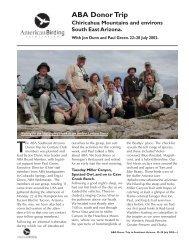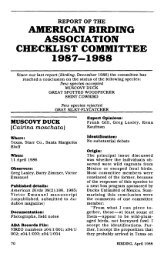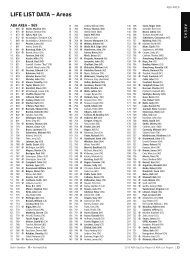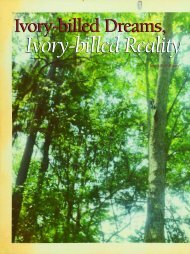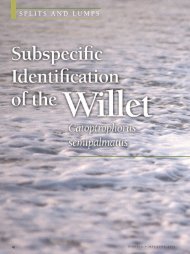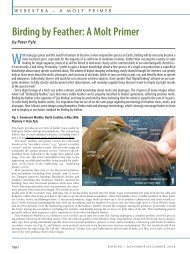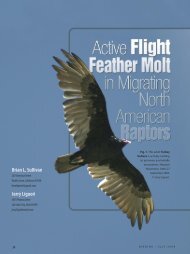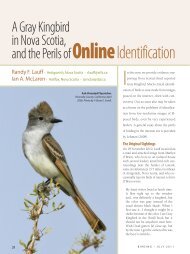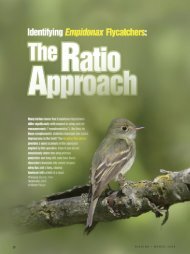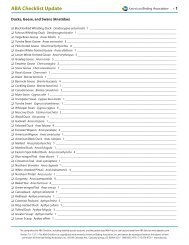PHOTO ESSAY: REDPOLLS FROM NUNAVUT AND GREENLAND VISIT ONTARIODistinguishing exilipes Hoary <strong>from</strong> nominate CommonAll of the distinctions illustrated in the field guides will help birderscorrectly identify a classic Common or Hoary Redpoll, <strong>and</strong> a carefulbirder would be unlikely to mistake a typical dark Common Redpollfor an adult Hoary. But there are many exceptions to the familiar fieldmarks. A few Commons, almost certainly males, show minimallystreaked undertail coverts <strong>and</strong> flanks, remarkably white rumps, <strong>and</strong> littlepink in the breast (especially in fresh plumage in autumn <strong>and</strong> earlywinter), thus closer to a Hoary. Likewise, a first-winter female Hoaryis generally the darkest of the post-juvenal plumages in that species,thus approaching female Common Redpoll in general appearance (Figures7, 8). (Note: the feathers referred to as the “rump” here are thosebetween the mantle <strong>and</strong> the uppertail coverts; Figure 9.)With birds away <strong>from</strong> the obvious extremes of typical Common orHoary, it is necessary to consider not just the well-known distinguishingfeatures but also the “soft” distinctions. Some exilipes Hoary <strong>Redpolls</strong>,for instance, show a markedly smaller red forecrown patch thana typical Common (Lansdown et al. 1991; Figures 5, 7). Most alsoshow less extensive black in the chin <strong>and</strong> lores than Commons of thesame age/sex, <strong>and</strong> this area of darker plumage in Hoary often looksmore gray or brownish gray than truly black (Knox <strong>and</strong> Lowther2000b; Figure 5-8, 10-12). Also, compared to nominate Common Redpoll,corresponding plumages of exilipes Hoary show much less pinkon the breast, with adult males often showing very little (Knox <strong>and</strong>Lowther 2000b; Figure 12). The quality of the pink is also typicallymuch less intense than in Common <strong>Redpolls</strong>, though there is muchvariation in this feature in Common (Lansdown et al. 1991). (Lightingconditions can either diminish or exaggerate this tone.) Some redpollobservers indicate that Hoary also shows not just more featheringaround the bill, on average, than Common but also more featheringaround the legs (Figures 6, 16). These features can be difficult to study,evaluate, <strong>and</strong> document. Description of most of them is subjective bynature—<strong>and</strong> some have in fact been called “useless” for distinguishingthese taxa. But they may be supportive of a case for identification thatis built primarily on other aspects of plumage.Distinguishing Hornemann’s <strong>from</strong> exilipes HoaryIts remote haunts <strong>and</strong> snow-white plumage made Hornemann’s Redpoll(Figures 13-14, 17-22) a subject of fascination for early NorthAmerican ornithologists. More recently, birders have attempted to familiarizethemselves with this taxon through the “Life Histories ofNorth American Birds” series edited by Arthur C. Bent, which containsextensive descriptions of both Hoary Redpoll subspecies (Austin1968, Baldwin 1968), <strong>and</strong> through illustrations in a few field guides(National Geographic Society 1983; Sibley 2000). But this taxon receivesrather thin treatment in most twentieth-century articles onHoary Redpoll identification (Lansdown et al. 1991, Jännes 1995,Votier et al. 2000) <strong>and</strong> in the Hoary Redpoll accounts in more recentspecialty guides (e.g., Beadle <strong>and</strong> Rising 2006). In fact, there havebeen very few convincing images of Hornemann’s published in NorthAmerica, <strong>and</strong> only a h<strong>and</strong>ful of birders know it well in life. Yves Aubry,Michel Gosselin, <strong>and</strong> Richard Yank (1987) wrote of Hornemann’s: “ahuge <strong>and</strong> distinctive white bird,” “a great rarity south of the tundra atany season.”Averaging 14.0 cm in length, Hornemann’s is the largest of all redpolltaxa, about 11% longer than most exilipes (averaging 12.5 cm)<strong>and</strong> slightly larger than Greater Redpoll (Knox <strong>and</strong> Lowther 2000b).Such size differences may seem slight, but they are sometimes apparentin the field when birds of different taxa are seen together (FiguresFigure 24. Seen face-on, Greater Redpoll’s more extensive black plumage around the bill gives it amore masked appearance than nominate Common, in some birds appearing almost ghoulish.Marathon, <strong>Ontario</strong>, 14 January 2011. <strong>Photo</strong>graph by Michael T. Butler.Figure 25. A Greater Redpoll <strong>and</strong> a Hornemann’s Redpoll take flight. Note the Greater’s dark featheringaround the tibia <strong>and</strong> very limited pale plumage in the rump. The breeding <strong>and</strong> winteringranges of these taxa overlap extensively, but their breeding biology has been little studied in recenttimes. Matheson, <strong>Ontario</strong>, 18 February 2011. <strong>Photo</strong>graph by Br<strong>and</strong>on R. Holden.Figure 26. When comparing sizes of redpolls, it is best to have them in the same plane <strong>and</strong> posture.The bird at right is likely a Greater Redpoll because it is so much larger than the accompanying exilipesHoary, but its plumage is very similar to nominate Common Redpoll. Matheson, <strong>Ontario</strong>, 18February 2011. <strong>Photo</strong>graph by Br<strong>and</strong>on R. Holden.V O L U M E 6 5 ( 2 0 1 1 ) • N U M B E R 2 213
PHOTO ESSAY: REDPOLLS FROM NUNAVUT AND GREENLAND VISIT ONTARIOFigure 27. An adult male Hornemann’s Redpoll (left), showing almost no streakingin the underparts, above a Greater Redpoll. This juxtaposition of the palest<strong>and</strong> darkest American redpoll taxa is seldom observed away <strong>and</strong> eastern <strong>Nunavut</strong><strong>and</strong> Greenl<strong>and</strong>. This adult male Hornemann’s Redpoll stayed well away <strong>from</strong> theflocking redpolls at the feeding station. Matheson, <strong>Ontario</strong>, 18 February 2011.<strong>Photo</strong>graph by Br<strong>and</strong>on R. Holden.15, 17, 18, 20)—<strong>and</strong> they are especially usefulwhen one is studying a plumage otherthan adult male (Figures 18, 19, 21). Hornemann’sexaggerates the features most associatedwith exilipes when compared to Common,appearing even whiter overall thanmost exilipes (in all parts of the plumage),with even bulkier body, longer wings <strong>and</strong> tail,thicker neck, <strong>and</strong> extensive featheringaround the tibia that look like wispy “pantaloons”—aphrase coined by Adirondackb<strong>and</strong>er John M. C. Peterson during what waslikely the largest irruption of Hoaries everrecorded in the eastern United States (Buckley<strong>and</strong> Kane 1974). Adult males have lesspink than exilipes, some showing only a traceof suffused pink on the breast, but some alsoshow pink in the rump (Knox <strong>and</strong> Lowther2000b; Figure 12). Adult females <strong>and</strong> firstyearbirds are not as blindingly white as adultmales but are often recognizable by their sizewhen compared directly to the smaller taxaflammea <strong>and</strong> exilipes (Figure 17, 18). Theseplumages appear to show more buffy tones inthe head, breast, <strong>and</strong> mantle <strong>and</strong> no pinkwhatsoever (Herremans 1991; van den Berget al. 2007).The American Ornithologists’ Union’sCheck-list Committee (A.O.U. 1998) suggeststhat the two taxa of pale redpolls “mayrepresent separate species, C. exilipes (Coues1861) [Hoary Redpoll] <strong>and</strong> C. hornemanni[Hornemann’s Redpoll].” In North America,the attractive Hornemann’s has been detectedas far <strong>from</strong> typical range as Fairbanks, Alaska(A.O.U. 1998). The mainl<strong>and</strong> of Europe hasrecords of Hornemann’s <strong>from</strong> near Abbeville,France (Degl<strong>and</strong> <strong>and</strong> Gerbe1867), at Bauvin, Pas-de Calais,France 1 February 1966 (Duboiset al. 2009), <strong>and</strong> on Ushant Isl<strong>and</strong>,France 19-21 October 1986(Dubois et al. 2008), as well as<strong>from</strong> Germany <strong>and</strong> Belgium(Hüppop 1996; Herremans1991), <strong>and</strong> a recent vagrantHornemann’s in Holl<strong>and</strong> was theoccasion for a paper that advocatedrestoring Hornemann’s to fullspeciesstatus (van den Berg et al.2007). It is certainly worth keepingHornemann’s in mind whenwatching redpolls anywhere.Distinguishing Greater Redpoll<strong>from</strong> nominate Common RedpollMuch as Hornemann’s Redpollcan be considered a larger, whiter,<strong>and</strong> less-streaked version of exilipesHoary, so Greater Redpoll resembles adarker, larger version of nominate Common,averaging about 10% longer <strong>and</strong> at least 25%heavier (Knox <strong>and</strong> Lowther 2000a). Whenobserved in direct comparison with nominateCommon—<strong>and</strong> even when observed alone—Greater has a distinctly different shape, witha heavier body (especially neck <strong>and</strong> breast),heavier bill, <strong>and</strong> longer tail (Beadle <strong>and</strong> Henshaw1996) (Figure 23). Many Greaters alsoseem to have a more bulbous culmen thannominate Commons (Beadle <strong>and</strong> Rising2006). Greater’s plumage tones are also darker,with reduced pale feather edgings in comparisonto nominate Common. The streakingof the underparts (breast, sides, <strong>and</strong> undertailcoverts) is heavier <strong>and</strong> darker in Greater thanCommon, the black adjacent the bill (chin,lores) is more extensive (Figure 24), <strong>and</strong> thenape <strong>and</strong> auriculars are also darker overall.The dark streaking below is so extensive thatit dominates the underparts, with manystreaks both thick <strong>and</strong> long/continuous (Figure25). The intensely rosy red tones of someadult male nominate Commons are almostnever matched by adult male Greaters, <strong>and</strong>Beadle <strong>and</strong> Rising (2006) indicate that maleGreaters show no red in the malar area,which male nominate Commons sometimesdo show. The more lightly marked Greaters(Figure 26), probably first-year birds, may bebest distinguished by their larger size—<strong>and</strong>often by their shape, both huskier in thechest <strong>and</strong> longer in the body/tail. Some observersassert that Greaters resting in trees appearto perch more upright than nominateCommons, <strong>and</strong> this tendency, combined withtheir larger size, darker plumage, <strong>and</strong> heavierbill, has led some observers to liken theirshape to that of House Finch (Carpodacusmexicanus).Closing thoughtsWhen studying redpolls, observers shouldalso be alert for subtle differences in behavior<strong>and</strong> should try to record vocalizations ofindividual birds that appear different. Someobservers who have spent a lot of timewatching mixed redpoll flocks have indicatedthat they can sometimes pick out an adultmale Hoary Redpoll in flight, though identificationshould be verified by plumage features.Many observers have described subtlebut distinctive differences in calls betweenHoary <strong>and</strong> Common, which agrees with thelimited literature on the subject (Knox 1988,Herremans 1989, Lansdown et al. 1991). Sostrikingly large <strong>and</strong> white were the Hornemann’sin mixed redpoll flocks in February2011 (Figure 27) that Br<strong>and</strong>on Holdencalled them the “abominable snow monsters.”Greaters may also be first detected byvocalizations; according to some, their callsgenerally sound harsher than those of nominateCommons.Observers in eastern Canada might alsowant to be on the lookout for the rather small,streaky Lesser Redpoll (A. cabaret) of Europe,a specimen of which was taken in easternGreenl<strong>and</strong> at Kuummiit on 6 September 1933(Boertmann 1994). And even closer to NorthAmerica, Common <strong>Redpolls</strong> that nest in Icel<strong>and</strong>,subspecies isl<strong>and</strong>ica, can be quite variable,with many appearing intermediate betweennominate Common <strong>and</strong> Greater, butsome birds being quite pale, very similar to exilipesor to the palest nominate Commons(Knox 1988, Lansdown et al. 1991, Pennington<strong>and</strong> Maher 2005). So how would one ruleout an Icel<strong>and</strong>ic Redpoll in the case of an “intermediate”-lookingbird in northeasternCanada, for instance? We do not know.There is surely much more to discover inour own backyards.AcknowledgmentsWe thank Ron Pittaway, Michael Butler, <strong>and</strong>Br<strong>and</strong>on Holden for their thorough, engagingeditings of early drafts of this <strong>Photo</strong> <strong>Essay</strong>.Arnoud van den Berg <strong>and</strong> Georges Oliosokindly helped with literature <strong>from</strong> Europe,<strong>and</strong> both have our gratitude.Literature citedAmerican Ornithologists’ Union [A.O.U.].1998. American Ornithologists’ Union214N O R T H A M E R I C A N B I R D S



